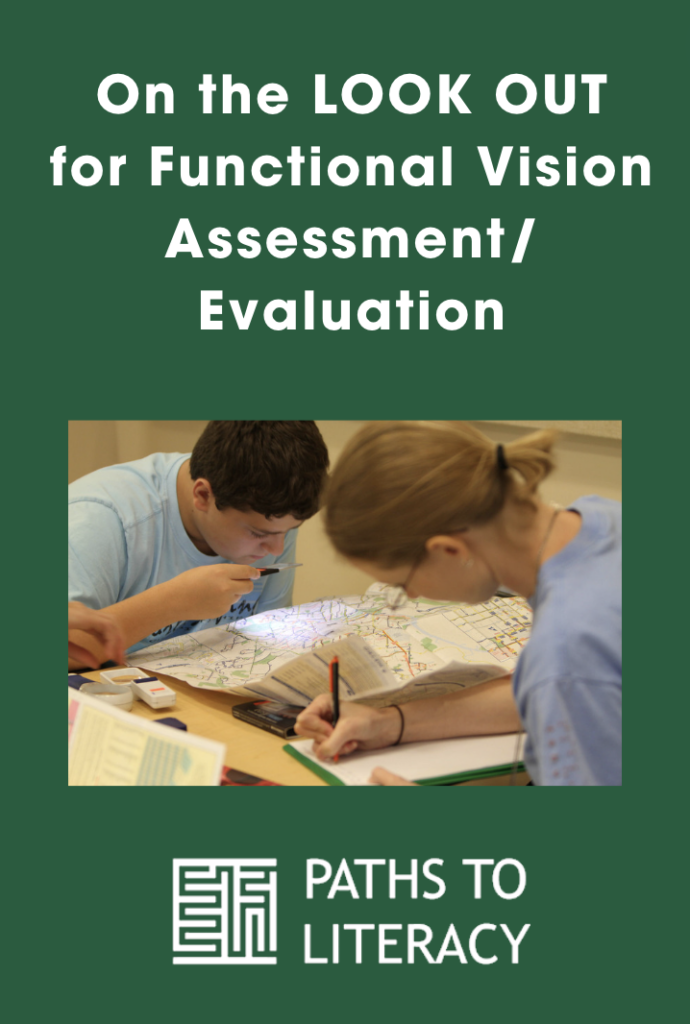Educational systems seem to thrive on acronyms. FVE, or FVA, is the short cut term for a functional vision evaluation or assessment, and is one acronym of especial importance when programming for students with visual impairments. Successfully educating these students depends upon access to accurate, current information about each child’s use of his/her vision. In Texas, a functional vision assessment report is the legally required document for bringing this information to an IEP committee. The report helps determine eligibility for services as a special education student with visual impairments. A second report, known as the learning media assessment, or LMA, is also required, to determine (in part) what kinds of literacy and functional learning materials are appropriate.
What is the purpose of a Functional Vision Assessment?
The FVA report is shared with the family and entire educational team, including assessment personnel, to ensure general knowledge of how to adapt and modify testing and instruction to best meet the unique needs of each eligible student. A good understanding of each student’s needs is necessary in order to properly modify materials, the distance at which materials should be displayed, lighting, seating, reading and writing tools, and other critical aspects of educational programming. Every child uses their vision differently, and even children with similar visual acuities and eye conditions may actually “see” in unique ways. For those who don’t see, or whose vision fluctuates and is unreliable, information on how to adapt instruction into tactual or auditory modes is critical for all staff. The functional vision assessment must be performed by a teacher certified in the area of visual impairments and/or an orientation and mobility specialist.
How often should the FVA be done?
The Federal law governing special education increasingly emphasizes active participation of parents in determining needed areas of assessment. Now, at the annual admission, review and dismissal meeting (ARD) or at specially called meetings, teams discuss together with family members what kinds of assessments should be conducted in order to best develop appropriate programming for each child. In a few cases, such as a stable eye condition or a student who wears prosthetics in both eyes, the functional vision assessment may not be needed to determine whether a student is still eligible as visually impaired. However, the FVA report is still an important report. It should be administered at least every three years, to assess whether programming modifications once appropriate to an earlier age and grade level are still applicable in new settings. Some students will be accessing the community more as they get older. Staff will need to look at visual information or modifications in work settings. In the early grades, materials are presented at quite different rates than in upper grades. Lighting, seating and activity requirements for student learning certainly change over time. The functional use of vision is dependent on many factors in addition to the medical cause of impairment. Medications, the presence of other disabilities, positioning, the type of school and classroom setting, expectations for demonstrating skills both in and out of school, motivation, age, and overall health can all be factors. A period of observation is critical in determining how each visually impaired child’s visual and learning needs should be addressed at regular intervals. This ensures adequate and appropriate modifications and instruction. This kind of information is captured in the FVA and can then be shared across the team.
What is the relationship between the FVA and a medical report?
The functional vision assessment (FVA) complements information available from an ophthalmologist or optometrist regarding medical diagnosis, care, prognosis, and health of the visual system. These medical eye specialists assess a child’s vision and visual system in their clinics and offices using specific techniques and equipment. That information should be summarized on the FVA report. It will inform and guide the assessment of functional vision by the certified educational staff. The FVA, paired with medical information, helps the VI teacher/O&M; describe how each eye condition translates into real life situations. Most of us have experienced reporting a problem to the doctor that simply doesn’t show up during examination. On the other hand, we may have problems at the doctor’s office that go away once we’re safely back home. The FVA report describes how a medical condition such as cataracts impacts the individual child’s functioning in the daily environment.
How should the FVA be administered?
A FVA must be based on observations of a child in a variety of settings, both indoors and out. It should be conducted at different times of day, across different environments, in the situations where the child is going to be asked to learn. Some children may need to be observed in a variety of positions since positioning may also impact visual functioning. Information from parents may indicate that going to the home is important, especially if they report that the child’s vision seems different in that setting. (For example, “He does fine until twilight, then he falls and bumps into things. Does he fall at school?”) The process can be quite straightforward for updating information on a familiar child whose vision is stable. However, repeated sessions over time may be required for new referrals, very young children, or children whose vision seems to be inconsistent.
Is it necessary to do a FVA on a child who has no vision?
There are children in the population with no vision, and functional vision reports are required for them, as well. In that case, the report confirms the absence of vision and presents recommendations on how to modify instruction for the student. The FVA report legally must also address, for all students, whether there is need for a low vision clinical evaluation, or assessment for orientation and mobility services.
What kind of information is included in the recommendations section?
The recommendations section of the functional vision assessment report presents guidelines on programming. It discusses the kinds of adaptations and modifications which will most impact learning. This section can be a primary vehicle for the VI professional to communicate the needs of this unique student to all other staff. Staff will want to post these recommendations on their walls and include them in their folders. It is also important that they use these recommendations to determine needed modifications during the IEP process.
What format should the FVA follow?
The FVA report is critical for ensuring coordination and consistency in educational programming and should be widely shared. There have been dozens of functional vision assessment forms developed. Some are essentially checklists, some are computerized forms customized for each child, and others include mainly narrative. There are a wide variety of styles and methods for testing and reporting. Recognizing that these reports are developed for infants, toddlers, school-aged children and young adults, it makes sense that the format and emphasis will differ by the child. It is helpful if it as free of jargon as possible so that all members of the educational team and the family can understand and implement the recommendations.
We are fortunate in Texas to have a system that requires the FVA. It provides teachers and assessment personnel with critical information about the impact of a child’s specific visual loss on learning. It guides them in modifying materials and the environment to build on each child’s strengths. The functional vision assessment is the cornerstone upon which an individualized student program can be created. This is one acronym to be sure to LOOK OUT for!
This article was originally published by Texas School for the Blind and Visually Impaired (Winter 1999) and is reprinted here with permission.





